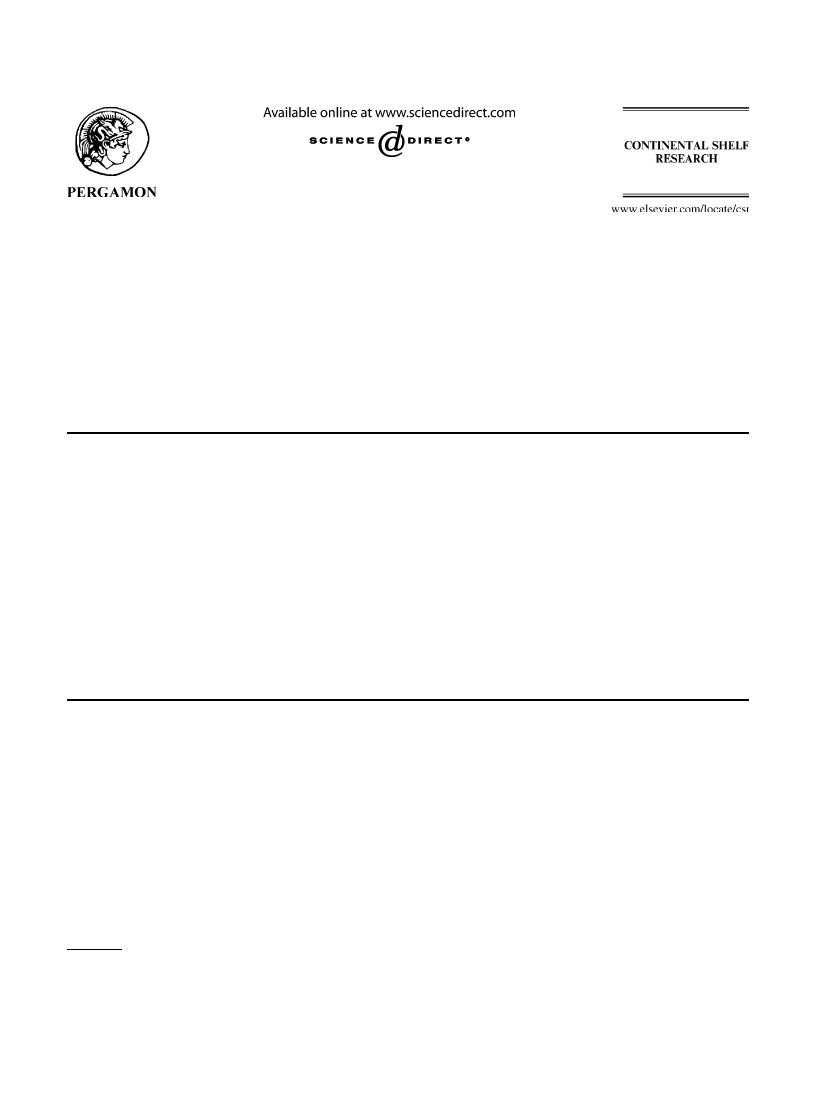
Continental Shelf Research 22 (2002) 26152631
Lateral dynamic analysis and classification of
barotropic tidal inlets
James L. Hencha,*, Brian O. Blantonb, Richard A. Luettich Jr.a
a
Institute of Marine Sciences, University of North Carolina at Chapel Hill, 3431 Arendell Street, Morehead City, NC 28557, USA
b
Department of Marine Sciences, University of North Carolina at Chapel Hill, 12-7 Venable Hall, CB 3300, Chapel Hill, NC 27599, USA
Received 21 December 2000; accepted 6 March 2002
Abstract
The dynamical balances at shallow tidal inlets are highly nonlinear, and can vary substantially over sub-kilometer
scales. In this study, barotropic dynamics are examined with numerical experiments on a series of idealized inlets with
differing inlet widths and lengths. Circulation and elevation fields obtained from fully nonlinear depth-integrated
circulation models are used to reconstruct the contribution of each term in the momentum equations. Momentum terms
are rotated into a streamline coordinate system to simplify interpretation of the dynamics. Spatial patterns in
momentum reveal that the lateral balances at inlets can vary from nearly geostrophic to strongly cyclostrophic. Marked
dynamical differences are seen between inlets with different lengths and widths. Inlet regions of geostrophic or
cyclostrophic balances can be predicted using two dimensionless parameters, the dynamic length L and dynamic width
W : A classification scheme is proposed using L and W to compare the idealized inlets analyzed here with inlets from
20 previous studies. Four distinct inlet types are identified and discussed.
r 2002 Elsevier Science Ltd. All rights reserved.
Keywords: Tidal inlet; Momentum balances; Streamline coordinates; Cyclostrophic; Geostrophic; Classification
numerical models are widely available, and amen-
1. Introduction
able to momentum balance calculations as the
physics included in the model are known a priori,
In the vicinity of an inlet with two opposing
and the circulation fields are deterministic. Several
headland features, one might expect dynamical
previous studies have used numerical coastal
similarities to single headland flows (e.g. Signell
circulation models to study inlet dynamics.
and Geyer, 1991), and if this is the case, the
Imasato (1983) developed a set of force balance
dynamics are, at a minimum, two-dimensional.
cartoons based on the results of an idealized inlet
Since the dynamics are also highly nonlinear,
model. Ridderinkhof (1988) computed steady-state
analytical analysis is rather intractable for the
momentum balance values using a model of a
most general cases. However, multidimensional
natural inlet in the Wadden Sea. Imasato et al.
(1994) computed vertical profiles of momentum at
*Corresponding author. Tel.: +1-252-726-6841; fax: +1-
selected points for another idealized inlet. Hench
252-726-2426.
and Luettich (in review) studied changes in
E-mail address: hench@unc.edu (J.L. Hench).
0278-4343/02/$ - see front matter r 2002 Elsevier Science Ltd. All rights reserved.
PII: S 0 2 7 8 - 4 3 4 3 ( 0 2 ) 0 0 1 1 7 - 6



 Previous Page
Previous Page
